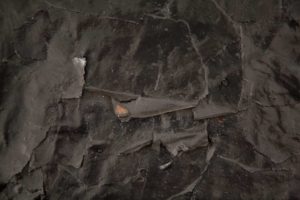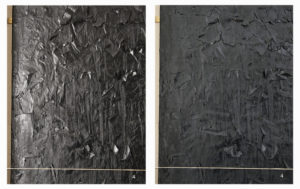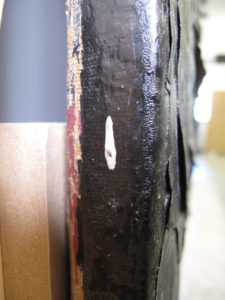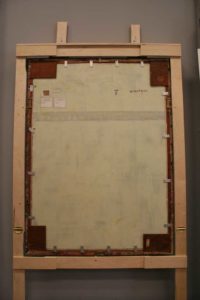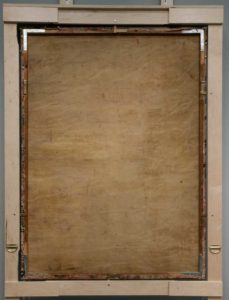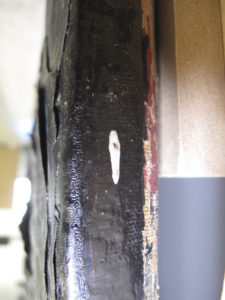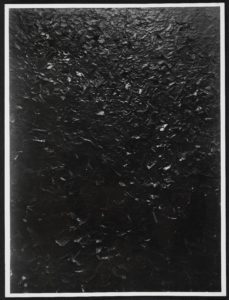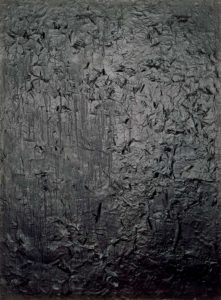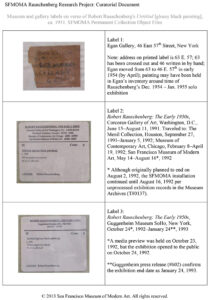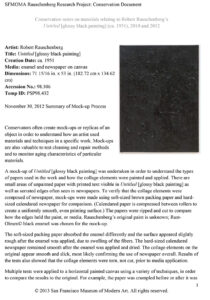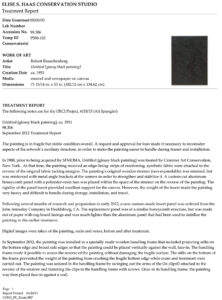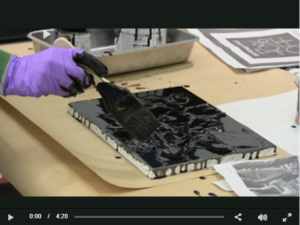Ownership History
San Francisco Museum of Modern Art, purchase through a gift of Phyllis Wattis, 1998
Exhibition History
Robert Rauschenberg: Selections, Fort Worth Art Center Museum, Fort Worth, Texas, January 5–February 2, 1969.
Rauschenberg: The White and Black Paintings 1949–1952, Larry Gagosian Gallery, New York, April 18–May 31, 1986.
ROCI USSR, Central House of Artists, Moscow, February 2–March 5, 1989.
Robert Rauschenberg: The Early 1950s, Corcoran Gallery of Art, Washington, D.C., June 15–August 11, 1991. Traveled to: The Menil Collection, Houston, September 27, 1991–January 5, 1992; Museum of Contemporary Art, Chicago, February 8–April 19, 1992; San Francisco Museum of Modern Art, May 14–August 16, 1992; Guggenheim Museum SoHo, New York, October 24, 1992–January 24, 1993.
Singular Dimensions in Painting, Guggenheim Museum SoHo, New York, May 26, 1993–January 4, 1994.
Robert Rauschenberg: A Retrospective, Solomon R. Guggenheim Museum, New York, September 19, 1997–January 7, 1998. Traveled to: The Menil Collection, Houston, February 13–May 17, 1998; Museum Ludwig, Cologne, Germany, June 27–October 11, 1998; Guggenheim Museum Bilbao, Spain, November 21, 1998–March 7, 1999.
Robert Rauschenberg, San Francisco Museum of Modern Art, May 7–September 7, 1999.
Points of Departure II: Connecting with Contemporary Art, San Francisco Museum of Modern Art, November 17, 2001–June 9, 2002.
Robert Rauschenberg at SFMOMA, San Francisco Museum of Modern Art, June 27–September 8, 2002.
Treasures of Modern Art: The Legacy of Phyllis Wattis at SFMOMA, San Francisco Museum of Modern Art, January 30–June 24, 2003.
Black Paintings, Haus der Kunst, Munich, September 15, 2006–January 14, 2007.
75 Years of Looking Forward: The Anniversary Show, San Francisco Museum of Modern Art, December 19, 2009–January 16, 2011 (on view through June 30, 2010).
50 Years at Pace: The Abstract Expressionist and Pop Art Years, Pace Gallery, September 17–October 23, 2010.
In addition to appearing in the special exhibitions listed above, Untitled [glossy black painting] was shown in SFMOMA’s galleries in 1999, 2000, 2003, 2004, 2005, 2006, and 2016 as part of a series of rotating presentations of the permanent collection.
This listing has been updated since the launch of the Rauschenberg Research Project and is complete as of August 31, 2016.
Publication History
Robert Rauschenberg: Selections (Fort Worth, TX: Fort Worth Art Center Museum, 1968), n.p. (ill.).
Walter Hopps, ed., Robert Rauschenberg (Washington, D.C.: National Collection of Fine Arts, Smithsonian Institution, 1976), 67 (ill.).
Rauschenberg: The White and Black Paintings 1949–1952 (New York: Larry Gagosian Gallery, 1986), n.p. (ill.).
Roni Feinstein, “The Early Work of Robert Rauschenberg: The White Paintings, the Black Paintings, and the Elemental Sculptures,” Arts Magazine 61, no. 1 (September 1986): 32, cover image.
———, “Random Order: The First Fifteen Years of Robert Rauschenberg’s Art, 1949–1964” (PhD diss., New York University, 1990), iii, 103.
Mary Lynn Kotz, Rauschenberg, Art and Life (New York: Harry N. Abrams, 1990), 77 (ill.).
Walter Hopps, Robert Rauschenberg: The Early 1950s (Houston: Menil Foundation and Houston Fine Art Press, 1991), 63, 67, 89 (ill.).
———, Robert Rauschenberg: The Early 1950s (Houston: Menil Foundation, 1991), 32. Exhibition booklet produced for the Menil presentation only.
ラウシェンバーグ [Rauschenberg], Gendai bijutsu 14 (Tokyo: Kodansha, 1993), n.p. (ill.).
Robert Rauschenberg: Man at Work, directed by Chris Granlund (London: BBC and RM ARTS, 1997), DVD, 57 min.
Walter Hopps and Susan Davidson, eds., Robert Rauschenberg: A Retrospective (New York: Solomon R. Guggenheim Museum, 1997), 23, 44, 62 (ill.).
Robert Rauschenberg, video interview by David A. Ross, Walter Hopps, Gary Garrels, and Peter Samis, San Francisco Museum of Modern Art, May 6, 1999. Unpublished transcript, SFMOMA Research Library and Archives, N 6537 .R27 A35 1999a, 36–39.
Kenneth Baker, “Rauschenberg Coup at SFMOMA: ‘Port of Entry’ a Major New Work,” San Francisco Chronicle, May 8, 1999.
“‘Points of Departure II’ at SFMOMA Explores Contemporary Art,” Antiques and the Arts, May 3, 2002.
Branden W. Joseph, Random Order: Robert Rauschenberg and the Neo-Avant-Garde (Cambridge, MA: MIT Press, 2003), 83 (ill.).
Stephanie Rosenthal, Black Paintings (Munich: Haus der Kunst, 2006), 27, 29, 101, 116–17 (ill.).
Bruno Marchand, ed., Robert Rauschenberg: Crítica e obra de 1949 a 1974 (Porto, Portugal: Fundação de Serralves, 2008), 49 (ill.).
Gerry Coulter, “Passings: Robert Rauschenberg and the Joy of Making,” International Journal of Baudrillard Studies 5, no. 2 (July 2008). Accessed June 23, 2013. https://www.ubishops.ca/baudrillardstudies/vol-5_2/v5-2-rauschenberg2.html.
“SFMOMA 75th Anniversary: Peter Samis,” interview conducted by Jess Rigelhaupt, 2008, Regional Oral History Office, The Bancroft Library, University of California, Berkeley, 2009, 8. Accessed June 23, 2013. https://bancroft.berkeley.edu/ROHO/projects/sfmoma/interviews.html.
Janet Bishop, Corey Keller, and Sarah Roberts, eds., San Francisco Museum of Modern Art: 75 Years of Looking Forward (San Francisco: San Francisco Museum of Modern Art, 2009), 146, 432.
“SFMOMA 75th Anniversary: David White,” interview conducted by Richard Cándida Smith, Sarah Roberts, Peter Samis, and Jill Sterrett, 2009, Regional Oral History Office, The Bancroft Library, University of California, Berkeley, 2010, 14, 17–25, 28–30. Accessed June 23, 2013. https://bancroft.berkeley.edu/ROHO/projects/sfmoma/interviews.html.
Yve-Alain Bois, Arne Glimcher, Marc Glimcher, et al., 50 Years at Pace (New York: Pace Gallery, 2010), 156 (ill.).
Dorothy Spears, “Pedigree and Promise in 50 Years at Pace,” Huffington Post, October 5, 2010. Accessed June 23, 2013. https://www.huffingtonpost.com/dorothy-spears/post_950_b_742537.html.
David Ebony, “Pace 50 Years and Counting,” Art in America 98, no. 10 (November 2010): 129 (ill.).
Nicholas Cullinan, “The Empty Canvas,” in Destroy the Picture: Painting the Void, 1949–1962, ed. Paul Schimmel (Los Angeles: Museum of Contemporary Art, 2012), 228 (ill. as Untitled).
Branden W. Joseph, Random Order: Robert Rauschenberg et la néo-avant-garde, trans. Anaël Lejeune, Olivier Mignon, and Raphaël Pirenne (Brussels: Continental Rift, 2012), 112 (ill.).
Rolando Pérez, Severo Sarduy and the Neo-Baroque Image of Thought in the Visual Arts (West Lafayette, IN: Purdue University Press, 2012), 273n41.
Richard H. Brown, “On Robert Rauschenberg, Artist, and His Work (1961),” A Year from Monday, January 9, 2012. Accessed June 23, 2013. https://www.ayearfrommonday.com/2012/01/on-robert-rauschenberg-artist-and-his.html.
Craig Staff, Monochrome (London: I.B. Tauris & Co., Ltd., 2015), 45 (ill.).
Summer Sewell, “Quality Control: Storing and Restoring at the New SFMOMA,” The California Sunday Magazine, May 12, 2016. Accessed August 15, 2016. https://story.californiasunday.com/sfmoma-preservation-storage.
This listing has been updated since the launch of the Rauschenberg Research Project and is complete as of August 31, 2016.
